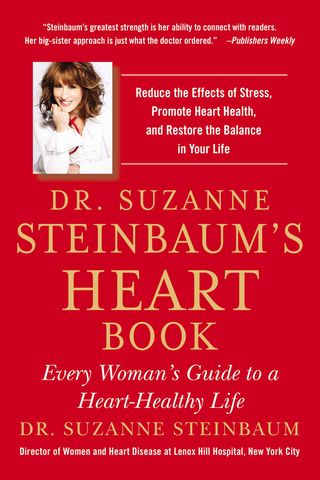
5 Tips to Ward Off Cholesterol Confusion (Op-Ed)

Dr. Suzanne Steinbaum is an attending cardiologist and the director of Women's Heart Health of Lenox Hill Hospital in New York City and has been featured on The Early Show, The Doctors, Good Morning America, 20/20 and other programs. She recently released her book "Dr. Suzanne Steinbaum's Heart Book: Every Woman's Guide to a Heart Healthy Life," (Avery, 2014) and is the host of Focus on Health, a weekly magazine news show spotlighting health topics, seen on WLNY-TV. Steinbaum contributed this article to LiveScience's Expert Voices: Op-Ed & Insights.
The controversy surrounding November 2013's release of cholesterol guidelines from the American Heart Association (AHA)-American College of Cardiology (ACC) continues, and the confusion amongst physicians and patients is widespread.
The release of related editorials today in The Annals of Internal Medicine lead us to understand how unsettling those guidelines have been, as physicians try to navigate a whole new set of rules, which discount some previous recommendations. As more patients become candidates for statins, the guidelines seem to leave out the shared decision-making that should take place between doctors and patients. As is often the case, many patients do not always fit into the general profiles the guidelines intended. The end result is the individual patient getting lost.
The guidelines set forth, without clear goals of treatment, have restructured when and how statins should be prescribed, whether at a moderate or high dose, depending on the new risk calculations. The new risk analysis has been shown to overestimate the risk of coronary artery disease over a 10-year period by as much as 70 percent to 150 percent. That being said, the guidelines continue to leave out the unique risks to women that have been ignored in the past. With all of this confusion, it's clear that patients must become both proactive consumers as well as educated and empowered health advocates.
When the AHA released guidelines regarding Women and Heart Disease in 2011, it demonstrated the critical importance of a woman's entire health history, including her gynecologic history in determining her risk for heart disease. Prior to this, a woman's whole health history was not a part of stratifying a woman's cardiovascular risk. According to these guidelines from the AHA, completely absent in the cholesterol guidelines from November 2013, women who have had partially elevated sugars, high blood pressure, diabetes, preeclampsia during pregnancy, or who have had multiple miscarriages, are considered at an increased risk of heart disease. In the new guidelines, although part of what increases risk is included — such as family history and ethnic background — the issues targeted in the 2011 women's guidelines are not part of the new risk analysis.
These new cholesterol guidelines were released without the benefit of a formal evidence-based peer review, nor any explanation of why prior practices are counteracted. Even moreso, they were released without the inclusion of multiple different stakeholders involved in the development of the guidelines. This has led to mistrust with patients and confusion amongst doctors, who are unclear how to move forward.
At present, the recommendation is for the patient to talk to his or her doctor, and at the same time to know how much personal health is in one's own hands. As we learn from these guidelines, lifestyle choices are critical, and the tipping point to start a statin in primary prevention (meaning for those patients who have not had heart disease) is a cholesterol number along with risk factors. But, individuals need to take more responsibility for their own numbers by making the best dietary choices, exercising, watching weight, not smoking and living an overall heart-healthy life.
Sign up for the Live Science daily newsletter now
Get the world’s most fascinating discoveries delivered straight to your inbox.

The reality is that the individual's role in heart health cannot be underestimated, particularly amidst controversy. We know that lifestyle choices can make a change in reducing statin numbers, and subsequently reduce the risk factors of heart disease, such as high blood pressure, diabetes and smoking. If each individual proactively changes his or her life, then the controversy of whether or not to start a stain would never need to exist.
In the re-release of my book, "Dr. Suzanne Steinbaum's Heart Book: Every Woman's Guide to a Heart Healthy Life," the issue of how much heart disease is a self-generated prophecy is constantly reaffirmed. When heart disease is 80 percent to 90 percent preventable, lifestyle choices are essential. Chapter 9, "Your Dietary Action Plan," addresses the new understanding and premise that diet might be just as important — or at least as a critical adjunct to statin treatment — and that what we eat may allow us to make our own choices about whether we do, or do not, need a statin. Staying heart healthy begins with making the right choices and then assessing the effect of those choices on heart health. When the issue of control is shifted from short sighted, limited and inconclusive guidelines to self-care, learning how to maintain your own heart health is essential.
Here are five tips from the book:
- The Mediterranean diet has been shown to reduce the incidence of cardiovascular disease by 30 percent. Heart health is achievable by including nuts and olive oil in a diet rich in fruits, vegetables, legumes and multiple grains. Adding omega-3 fatty acids in the form of fish, avocado and olive oil is the cornerstone of the Mediterranean diet.
- Include foods that are high in antioxidants, polyphenols and bioflavonoids. Tea, dark chocolate and red wine, are some of the foods that are filled with these heart-healthy ingredients and part of a preventative diet.
- My mantra that "exercise is the best medication" is a critical part of a heart-healthy life. Exercising at moderate intensity for 150 minutes a week provides cardiovascular protection including decreasing blood pressure, cholesterol, and diabetes risk, and improves mood.
- Self-care in the form of stress management, sleep, intimacy and nutritional supplements can help in caring for the heart. There is a significant connection between the mind and body, so caring for both is essential.
- Getting testing done to personally know your risk is vitally important. Not only does the American Heart Association suggest "knowing your numbers," such as blood pressure, cholesterol, sugars, and body mass index, other tests can help determine if we are at risk for cardiovascular disease, such as a CRP (an inflammatory marker, it is a coronary artery calcium score that looks for calcium in the artery which is associated with plaque) and an EndoPAT score, which evaluates the health of the lining of the artery. The EndoPAT can determine if the artery is healthy by obstructing blood flow to the fingers with a blood pressure cuff and then releasing it, allowing quick and rapid blood flow to the fingers. Probes placed on the fingertips can determine the arteries' ability to dilate, which is a sign of arterial health.
After sifting through the controversy, the take-home message is consistent. We must empower ourselves to take care of our own hearts as best and as much as we can, without relying on an imperfect system.

When it comes down to it, prevention begins with the dietary choices and lifestyle habits that we make, and then, if we need a little help, the guidelines exist to aid in guiding treatment. In partnership with a doctor, we need to calculate our own risk factors, go over the cholesterol numbers, and then determine how much of a statin we need. It is an effort worth making, as the bottom line of these guidelines is clear — to prevent heart disease and save lives.
About the author: Steinbaum has lectured nationally on coronary artery disease, women and heart disease, alternative ways of treating heart disease, and prevention, and she is a national spokesperson for Go Red for Women through the American Heart Association. She has been awarded a New York Times Super Doctor award and a Castle and Connelly Top Doctor for Cardiovascular Disease award, and also has done fellowship training in both preventive cardiology and cardiology.
The views expressed are those of the author and do not necessarily reflect the views of the publisher. This version of the article was originally published on LiveScience.












